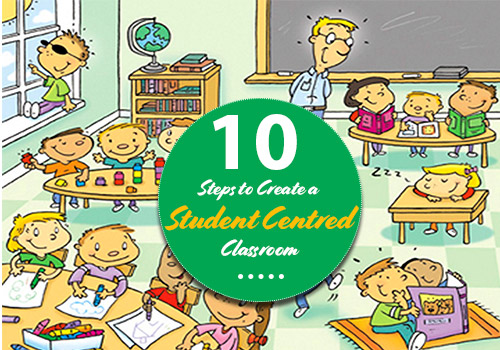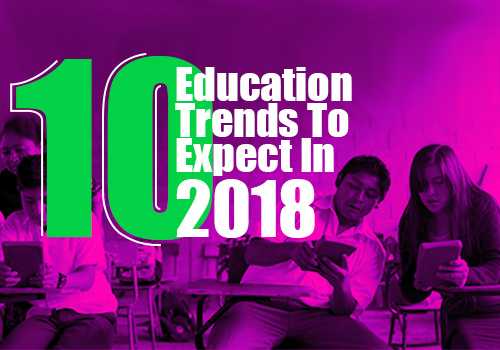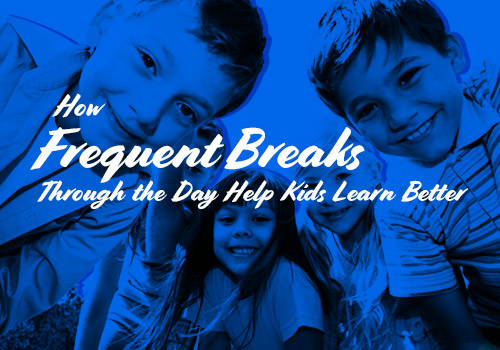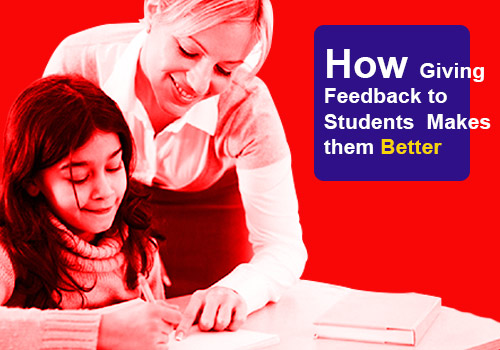Good news awaits all the educators, students and school administrators for the year ahead.
Much to the surprise of all the stakeholders, a number of exciting trends are predicted to shape up, revolutionizing the educational sphere.
The year 2018 is all set to shed light on a number of concerns and topics that are poised to transform the way educators teach and students learn.
If you are keen on exploring the much anticipated and imminent educational trends that will make a mark for themselves in 2018, here is a long list of 15 such instances that can be expected.
-
The Internet Will Continue to be the Omnipresent and Omnipotent Learning Tool
It is now the age of technological learning that provides umpteen learning opportunities to students and teachers alike. With the booming use of internet, students will expect the seamless use of technology in classrooms as well. Since technology has already penetrated into their homes, the present generation students would be poised to bank on the internet to realize all their learning aspirations.
Students can rely on web portals to submit educational projects and assignments. Paving the way for computerization of schools, the internet will continue to provide the much-needed, unlimited access to information for students.
-
Augmented Reality Will Rule the Roost
A number of studies that were conducted over the last couple of years have put the technology behind Augmented Reality (AR) on a pedestal. AR is the buzzword that will enhance learning alongside improving classroom interactions. Students who bank upon AR will enjoy experiential learning alongside motivating them to perform better in studies.
AR is the next big thing for tertiary learning institutes like colleges and universities. The year 2018 will witness AR to transform into a mainstay learning technology, especially for subjects like humanities, arts and sciences. AR will team up with 3D modeling software systems, allowing you to submit 3D assignments and project presentations; from your smart devices. Students majoring in architecture can employ this technology to build 3D models and assist them in their college and university project submissions.
-
Widened Scope for Paraprofessionals
Paraprofessionals who support the activities of teachers will witness a plethora of opportunities in 2018. They will bring in quality learning experiences through a number of creative methods. Paraprofessionals will have access to information that will hone their skills so that they can employ them for the collective welfare of the students of a classroom. The year 2018 will see the rise of professional development opportunities for these paraprofessionals for different school districts attached to every country.
-
A Rise in Cost of Education Continues
College education is becoming expensive on account of many reasons. Inflated costs will definitely fleece the budget of colleges, forcing them to compensate through an increased tuition fee. Along with a deliberate cut in state funding for education, public schools and colleges are forced to jack up their tuition fees. This trend of high education costs will make its strong presence felt in 2018 as well. Given the fact that low-income students are finding it difficult to enroll for college education, colleges have decreased the college enrolment fees, eventually hiking the tuition fee.
-
Trauma-Informed Practices Will Experience a Fillip
The future lies with educationalists having a keen interest in information concerning trauma-informed practices. The present day educators and students are relying on the professional resources which can ease the effects of trauma. It is an eye-opener to know that students under the age of 16 have already experienced the debilitating effects of stress. Given the number of factors can lead to stress in students, it is for the educators to identify them. Once these are recognized, it is for the administration to come up with strategies aimed at better management of classrooms. These trauma-informed practices will help new age students to counter and surpass any sort of educational or behavioral stumbling blocks they encounter.
-
Flipped Classrooms – The New Age Learning Arenas
Google Classroom and Microsoft Teams along with One Drive will soon become the indispensable learning tools in modern schools. Flipped classrooms will continue to make their presence felt in education, guaranteeing the benefits of collaborative learning. The year 2018 will make these online learning tools very significant and pivotal to students to make the most of modern educational practices.
-
Niche Learning – The New Kid on the Education Block
All in an attempt to address the increased demand for skilled professionals required by various industries, it is the need of the hour to tread the path of niche learning. Enrolments to certification courses will see a rise with organizations spending monies on equipping their workforce with on-the-job trainings and certifications. This trend is expected to open up millions of jobs for certified professionals. It is for these certifications that schools will tie up with industries who are scouting for skilled workers. This will lead to a smooth transition for the learned to pass out of college and immediately get placed in companies scouting for trained professionals.
-
Micro-Credentialism Will Witness A Major Push
Similar to niche learning that is the much-needed form of education to thrive in this highly-competitive business environment, the concept of micro-credentialism is steadily gaining ground. Businesses are no longer in need of students who attend colleges in pursuit of knowledge about various subjects. On the contrary, they are constantly on the lookout for professionals who are abreast with the working of a streamlined vocational environment. It is through micro-credentialism that students of the present generation will have to sign up for niche learning courses so as to fill the widening gap between the demand and supply of skilled labor.
-
The Use of Collaboration Tools Will Witness a High
In 2018, as in the previous years, students will rely on technology to not only socialize and make friends but also to collaborate. While this is an external parameter to a classroom, this trend is expected to percolate into the classroom as the entire class will use similar technologies to make education enjoyable. This will not only set the stage for students to learn from each other, but also to engage better with their topics.
-
The Prominence of Video Communication Tools
Google Expeditions is a Virtual Reality (VR) learning tool that allows students to enjoy virtual trips by travelling to any nook and corner of the globe. This is a video communication tool that holds great promise to students of modern times to enjoy real-life learning experiences that are far-fetched with traditional teaching styles. Such video-driven learning tools permit you to make the most of online content that makes visuals thrilling to watch and learn.
-
The Modern Age of Data-Centric Schools
Another educational trend that you should be in the know of concerns the use of statistical information in school management. Be it the seamless monitoring of attendance registers or the storage of educational projects, the year 2018 is all set to witness a sea change. Schools will begin to incorporate a widespread use of EMIS (Education Management Information System) so as to better monitor the performance of both students and teachers alike. EMIS helps schools to have up-to-date and relevant information that can be retrieved effortlessly. With the EMIS in place, schools will be in a strong position to make better decisions when they can compare past trends to current happenings.
-
Reading Will Become A Pleasure Through E-Books
It is not an overstatement to quote that e-books have a positive impact on the reading habits of students who are reluctant to hold a book in their hands. You can now pick an e-book of your choice and read it so as to not only improve your reading skills but also for the sheer pleasure of befriending black and white text. By 2018, you can expect all the schools to employ e-books as promising reading tools to make the assimilation of knowledge a pleasure for life.
-
The Upcoming Benefits for Teaching Fraternity
New age teachers will begin to enjoy better career pathways through typical classroom practices like teacher leadership roles and mentoring skills. Given the fact that teaching is considered a flat career without any promotions, the attrition level in the teaching line is quite high.
Some teachers will sign up for new teacher mentoring roles while some become instructional coaches. It is through these novel career options that a fresh breathe of life can be bestowed to teachers. These education-centric admin roles that the teachers will embrace will help them gain recognition for their expertise in the fields of delivering curriculum. They will also become the vital instrumentals in the growth of new teachers who are aspiring to teach and inspire students.
-
Teacher Shortage Continues To Be A Matter of Concern
Shortage of teaching staff linked to subjects like science, math and special education will still persist in 2018 apart from registering a rise. While schools continue to face a serious shortfall of teachers, it is also crucial to retain new teachers. With a steady rise in the number of school-going students coupled with a low teacher retention rate, most of the schools, across the globe will face an acute shortage of teachers in 2018 as well.
-
The Growing Popularity of Inclusive Practices in Education
The year 2018 will witness a steady popularity of inclusive educational practices. It is through such practices that differently-abled students can be brought into the educational mainstream. These practices will help such students to excel in their academics through an endearing support coming from educators. Enabling them to meet their numerous learning needs, a free-thinking and a collaborative learning pattern will support them in more ways than one.
Closing Thoughts
There is so much in store for all the stakeholders concerning the sphere of education in 2018. The above-explained pointers highlight the developments that you can expect in 2018. It is through these fact-based predictions that you can come to a conclusion that a paradigm shift in education is imminent and here to stay.









![35 Free Educational Websites You Shouldn’t Miss [Infographic]](https://wp.edsys.in/wp-content/uploads/2018/03/19-02-2018_35-Free-Educational-Websites-You-Shouldnt-Miss_featured-image.jpg)

